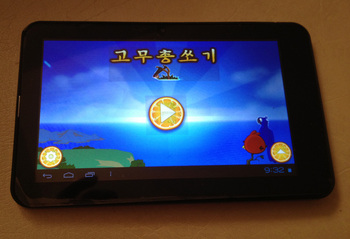North Korean Android based tablet
 A tourist who has visited one of the most closed countries in the world shared with the IDG News Service information about the Internet tablet that he acquired in his birthplace of the Juche ideology. Specifications and pre-installed software once again remind about the policy of isolating the DPRK.
A tourist who has visited one of the most closed countries in the world shared with the IDG News Service information about the Internet tablet that he acquired in his birthplace of the Juche ideology. Specifications and pre-installed software once again remind about the policy of isolating the DPRK.The device called "Samiyon" (probably, the name is given in honor of the city of the same name) is the third tablet released in North Korea. Most likely, it is produced outside the country, the technical capabilities of the DPRK do not allow the production of consumer electronics, although the state is able to prepare its own software for the purchased hardware. It was first demonstrated at the industrial exhibition in Pyongyang last September. They talked about it on North Korean television, but very few foreign tourists could see it closely.
The history of the acquisition was very simple: a tourist, who prefers to be called only the name Michael, noticed a device in a gift shop in a restaurant and was surprised by this. Bored while waiting for the smoking part of the group, Michael asked if he could take a picture of the device. Joking, he even asked if the tablet was being sold. To his surprise, the answer was positive, the price was only $ 200. (For comparison: the average salary of a DPRK citizen is less than $ 100. For an ordinary resident, Samiyon is a luxury item.)
The device’s technical specifications are modest: it has a seven-inch screen with a resolution of 1024 × 768 pixels, a 2-megapixel camera, and a 1.2 GHz processor. The tablet software is of more interest: it runs on a customized version of Android 4.0.4 Ice Cream Sandwich. Michael describes the tablet as surprisingly easy to use: the interface works without slowing down, and the camera is initialized as fast as it happens in the flagship models of the largest manufacturers in the world. Michael plays the "birds" without lags of graphics and control.
')
There are no Google services among the pre-installed programs; There are no YouTube and Gmail applications on the tablet that require licensing, but all the usual icons are in place. These include an image gallery, calculator, camera and internet browser. The Internet is not available to most of the population of the DPRK, although many have access to the internal network of the country, which has tightly controlled email and video streaming services.
Curiously, the tablet has some programs developed in the West, including Angry Birds. Among North Korean applications: a glossary of information technology, a multilingual dictionary, an application with the history of Korea, Korean chess and a set of books to study the idea of Juche, the national ideology of the DPRK.
There are four preset bookmarks in the browser: this is the main news agency in North Korea, the main daily newspaper served by the Korean Computer Center portal and state television. Only the first three resources are accessible from the usual Internet, in the “Samiyon” tabs, links to the internal sites of the Korean intranet are used. Despite the availability of a browser and bookmarks, Michael failed to get online. From the configuration files far inside the system, it was possible to conclude that the tablet may have a WiFi module, but either it is not installed or configured to work only in some networks.
State media praise Samiyon as a device useful to students. Indeed, it has several educational applications, one of which provides a virtual bookshelf with books about music, computers, mathematics, as well as helping to study the revolution (biographies of national leaders, etc.)
Interestingly, the tablet is equipped with a TV tuner compatible with North Korean analog TV. His channels are pre-installed and cannot be changed, most likely, this is done so that the user does not listen to various foreign “voices”. It is alleged that Pyongyang can catch two stations.
Source: https://habr.com/ru/post/188854/
All Articles